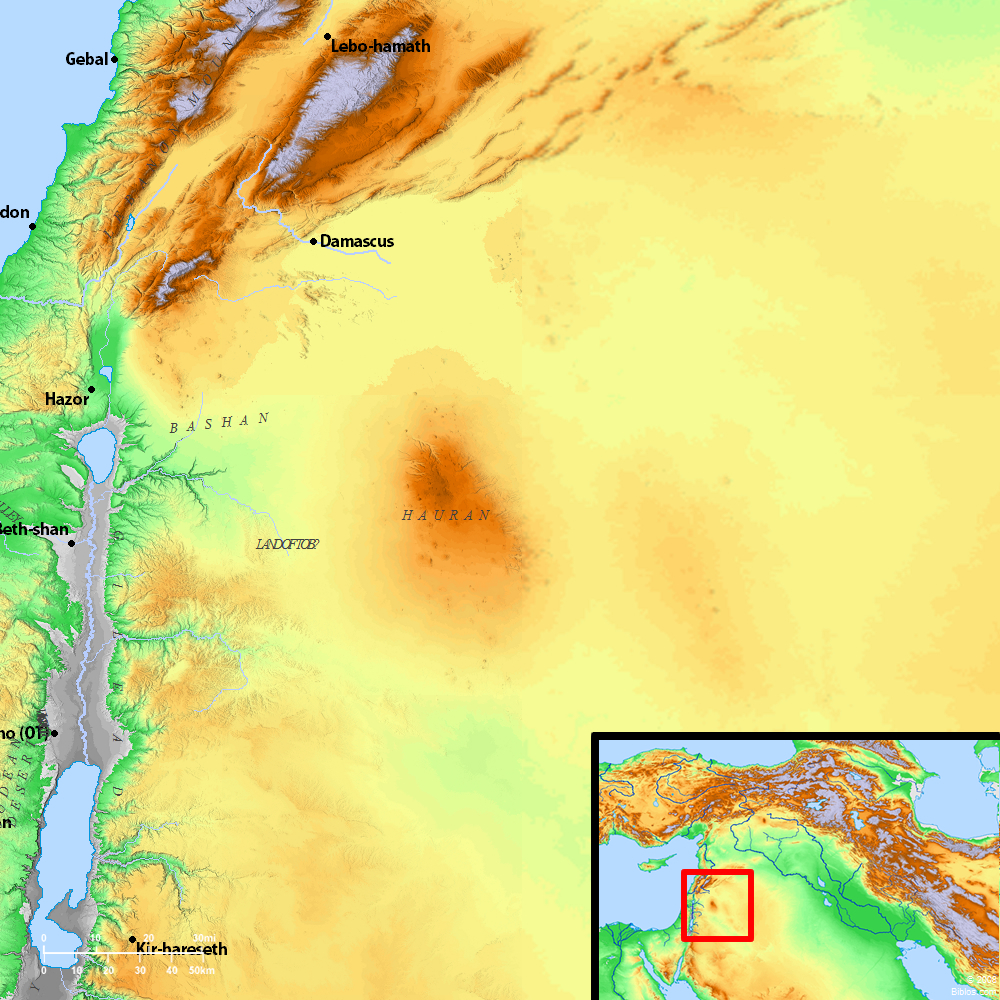Atlas

Hauran and surrounding region
Maps Created using Biblemapper 3.0Additional data from OpenBible.info
You are free to use up to 50 Biblos coprighted maps (small or large) for your website or presentation. Please credit Biblos.com.
Occurrences
Ezekiel 47:16 Hamath, Berothah, Sibraim, which is between the border of Damascus and the border of Hamath; Hazer Hatticon, which is by the border of Hauran.
Ezekiel 47:18 The east side, between Hauran and Damascus and Gilead, and the land of Israel, shall be the Jordan; from the north border to the east sea you shall measure. This is the east side.
Encyclopedia
HAURANho'-ran (chawran; Septuagint Auranitis, also with aspirate):
1. Extent of Province in Ancient Times:
A province of Eastern Palestine which, in Ezekiel 47:16, 18, stretched from Dan in the North to Gilead in the South, including all that lay between the Jordan and the desert. It thus covered the districts now known as el-Jedur, el-Jaulan, and el-Chauran. It corresponded roughly with the jurisdiction of the modern Turkish governor of Hauran. The Auranites of later times answered more closely to the Hauran of today.
2. Modern Hauran:
The name Chauran probably means "hollow land." Between Jebel ed-Druze (see BASHAN (MOUNT OF) on the East, and Jedua and Jaulan (see GOLAN) on the West, runs a broad vale, from Jebel el `Aswad in the North, to the Yarmuk in the Southwest, and the open desert in the Southeast. It is from 1,500 to 2,000 ft. above sea-level, and almost 50 miles in length, by 45 in breadth. Chauran aptly describes it. To the modern Chauran are reckoned 3 districts, clearly distinguished in local speech:
3. En-Nuqrah:
(1) En-Nuqrah, "the cavity." This district touches the desert in the Southeast, the low range of ez Zumleh on the Southwest, Jaulan on the West, el-Leja' on the North and, Jebel ed-Druze on the East. The soil, composed of volcanic detritus, is extraordinarily rich. Here and there may be found a bank of vines; but the country is practically treeless: the characteristic product is wheat, and in its cultivation the village population is almost wholly occupied.
4. El-Leja':
(2) El-Leja', "the asylum." This is a rocky tract lying to the North of en-Nuqrah. It is entirely volcanic, and takes, roughly, the form of a triangle, with apex in the North at el Burak, and a base of almost 20 miles in the South. For the general characteristics of this district see TRACHONITIS. Its sharply marked border, where the rocky edges fall into the surrounding plain, have suggested to some the thought that here we have chebhel 'argobh, "the measured lot of Argob." See , however, ARGOB. There is little land capable of cultivation, and the Arabs who occupy the greater part have an evil reputation. As a refuge for the hunted and for fugitives from justice it well deserves its name.
5. El-Jebel:
(3) El-Jebel, "the mountain." This is the great volcanic range which stands on the edge of the desert, protecting the fertile reaches of el-Chauran from encroachment by the sand, known at different times as Mons Asaldamus, Jebel Chauran, and Jebel ed-Druze. This last is the name it bears today in consequence of the settlement of Druzes here, after the massacre in Mt. Lebanon in 1860. Those free-spirited people have been a thorn in the side of the Turks ever since: and whether or not the recent operations against them (January, 1911) will result in their entire, subjugation, remains to be seen. The western slopes of the mountain are well cultivated, and very fruitful; vineyards abound; and there are large reaches of shady woodlands. Calkhad, marking the eastern boundary of the land of Israel, stands on the ridge of the mountain to the South Jebel el-Kuleib in which the range culminates, reaches a height of 5,730 ft. Jebel Chauran is named in the Mishna (Rosh ha-shanah, ii.4) as one of the heights from which fire-signals were flashed, announcing the advent of the new year. For its history see BASHAN. The ruins which are so plentiful in the country date for the most part from the early Christian centuries; and probably nothing above ground is older than the Roman period. The substructions, however, and the subterranean dwellings found in different parts, e.g. at Der`ah, may be very ancient. The latest mention of a Christian building is in an inscription found by the present writer at el-Kufr, which tells of the foundation of a church in 720 A.D. (PEFS, July, 1895, p. 275, Inscr number 150). A good account of Hauran and its cities is given in HGHL, XXIX, 611.
W. Ewing
HAURAN, now a district with some ruined cities 25 to 30 ms. e. of the sea of Tiberias, but it is probable that the only mentions (Ezek. 47:16, 18) had reference to a city by that name, now unknown.
Strong's Hebrew
H2362: Chavrana district Southeast of Mount Hermon




